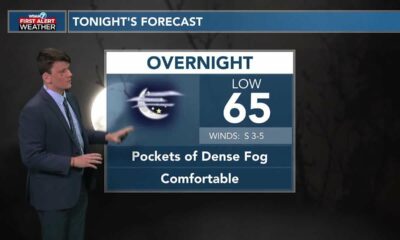Kaiser Health News
ER’s Error Lands a 4-Year-Old in Collections (For Care He Didn’t Receive)
by Daniel Chang
Wed, 29 Mar 2023 09:00:00 +0000
Dr. Sara McLin thought she made the right choice by going to an in-network emergency room near her Florida home after her 4-year-old burned his hand on a stove last Memorial Day weekend.
Her family is insured through her husband's employer, HCA Healthcare, a Nashville-based health system that operates more hospitals than any other system in the nation. So McLin knew that a nearby stand-alone emergency room, HCA Florida Lutz Emergency, would be in their plan's provider network.
But McLin said a doctor there told her she couldn't treat her son, Keeling, because he had second- and third-degree burns that needed a higher level of care. The doctor referred them to the burn center at HCA Florida Blake Hospital, about a 90-minute drive away.
McLin, who is a dentist, said the doctor told her the stand-alone ER would not charge for the visit because they did not provide treatment.
“I don't remember exactly how she phrased it. But something along the lines of, ‘Well, we won't even call this a visit, because we can't do anything,'” McLin said.
At Blake Hospital, she said, a doctor diagnosed Keeling with a second-degree burn, drained the blisters, bandaged his hand, and sent them home with instructions on how to care for the wound.
“I didn't think anything more of it,” McLin said.
Then the bills came.
The Patient: Keeling McLin, now 5, is covered by UnitedHealthcare through his father's employer.
Medical Service: At the stand-alone emergency room, a physician assessed Keeling and sent him to another facility for treatment. “Keeling needs a burn center,” the doctor wrote in the record of his visit.
Service Provider: Envision Physician Services, which employed the emergency room physician at HCA Florida Lutz Emergency in Lutz, Florida, near Tampa, and HCA Florida Trinity Hospital, the main, for-profit hospital to which the stand-alone emergency room belonged.
Total Bill: For the emergency room visit, Envision Physician Services billed $829 to insurance and about $72 to the family. HCA Florida Trinity Hospital billed Keeling about $129, noting it had applied an “uninsured discount.” An itemization showed the original charge had been nearly $1,509 before adjustments and discounts.
What Gives: The stand-alone emergency room and ER doctor, who saw Keeling but referred him to another hospital, billed for his visit. But McLin soon learned she was unable to dispute some of the charges — because her young child's name was on one of the bills, not hers.
Months after the ER visit, McLin received a bill addressed to the “parents of Keeling McLin” from Envision Physician Services, the provider staffing service that employed the ER doctor at Lutz. McLin recalled the doctor's promise that they would not be billed. “I should have made them write something down to that effect,” she said.
She said she called her insurer, UnitedHealthcare, and a representative told her not to pay the bill.
She received an insurance statement that identified the bill from Envision's doctor — an out-of-network provider working in an in-network emergency room — as a “surprise bill” for which the provider may charge only copays or other cost-sharing costs under federal law. McLin said she had not heard anything since then about the bill.
After being contacted by KHN, Aliese Polk, an Envision spokesperson, said in an email that Envision would waive the debt, apologizing to Keeling's family “for the misunderstanding.”
She described the ER doctor's evaluation, determination, and referral as a medical service. She said the bill was for cost sharing for the visit — not the difference between what the doctor charged and what insurance paid, as the law prohibits.
“We recognize the patient's family may have understood at the time of treatment that there would be no charge for the visit, including the medical service provided by our physician,” Polk said. “Unfortunately, this courtesy adjustment was not captured when the claim was processed.”
Maria Gordon Shydlo, a UnitedHealthcare spokesperson, said the insurer believed the matter had been resolved and did not follow up on requests for an interview, even after McLin waived federal health privacy protections, which would allow the insurer to speak to the reporter about the case.
McLin also received a bill from HCA Florida Trinity Hospital for its stand-alone ER at Lutz and decided to dispute the charges.
But after calling the hospital to appeal, McLin said, the billing department would not discuss the debt with her because the statement was in her young son's name.
“They had him as the guarantor,” McLin said. Unlike Envision, which billed Keeling's parents and their insurance, McLin said the hospital listed the child as “unemployed, uninsured.”
The child's ER record also included his date of birth and doctor's notes referencing his age. McLin said she wrote to HCA in November asking to appeal the bill and that a billing representative told her over the phone that it would put the debt on hold and review the dispute.
“I never heard anything back and assumed we were good,” McLin said.
Then, in January, she received a letter from Medicredit, a collection agency and an HCA subsidiary, stating that Keeling owed $129 and that he had until mid-February to contest the debt. KHN was unable to make contact with Medicredit representatives, and HCA Healthcare did not respond to requests for comment from its subsidiary.
Once again, Sara McLin's name was not on the debt collector's letter, and she said Medicredit representatives refused to discuss the debt with her because it was in her son's name. She said she called HCA, too. “They said, ‘We can't help you. We don't have the case anymore,'” she said.
Erin Fuse Brown, a law professor and director of the Center for Law, Health & Society at Georgia State University, said McLin did everything right and that it is unusual for a parent to be barred from discussing a debt related to their minor child.
“The fact that the hospital wouldn't even talk to her strikes me as the part that is absurd. It's absurd as a business matter. It's absurd as a privacy matter,” Fuse Brown said, adding that federal health privacy laws allow a parent or legal guardian to access their dependent's medical information.
Fuse Brown said the hospital should have been able to correct the error quickly with more information, such as a birth certificate or other document establishing that McLin was Keeling's parent. At the very least, she said, it could have given McLin notice before sending the bill to collections.
“You get the feeling that it's this large, automated process, that there's no human to get through to, that there's no human to talk to and override the mistake,” Fuse Brown said. “Maybe it's routine, but she couldn't even talk to someone to correct a correctable billing error, and then the system just steamrolls over the patient.”
The Resolution: When the collection agency's deadline passed without resolution, McLin said she felt frustrated. “Nobody can explain to me who has to approve talking to me,” she said. “I don't know who that person is or what the process is.”
After KHN contacted the health system, HCA Healthcare canceled the family's debt. HCA representatives declined to be interviewed on the record despite also receiving a privacy waiver from McLin.
“We have attempted to contact Mrs. McLin to apologize to her for the inconvenience this has caused her and to let her know that there is a zero balance on the account,” Debra McKell, marketing director for HCA West Florida Division, said in an email on March 3. “We also will be sharing with her that we are reviewing our processes to ensure this does not happen again.”
McLin later received a letter from HCA stating that the account had been cleared. She also said she received a call from a customer service representative informing her that the debt had not been reported to any credit agencies.
She said she was pleased, but that patients should not have to struggle to correct a billing error before it is sent to a collection agency and potentially ruins their credit.
“It's the principle of the thing that's annoying me at this point,” she said.
The Takeaway: Though the notion of a debt collector pursuing a 4-year-old boy may seem farcical, it happens. When seeking medical care for a minor, it is important for the parent or guardian to ensure their name is listed as the responsible party.
Consumers who find themselves fighting a medical billing error need to “think like a lawyer,” Fuse Brown said, including documenting every interaction with the debt collector, getting any promises in writing, and recording phone calls. (State laws vary about how many parties on a call must give permission to record a conversation.)
Patients do not have to give up once a bill goes to collections, Fuse Brown said. “Once you hear from a debt collector, it's not like the game is over and you lose,” she said. “Consumers do have rights.”
François de Brantes, a home health company executive and expert on how money flows through the health care system, said that hospital billing errors are not uncommon but that he had never heard of a situation like the one McLin experienced. He called it “puzzling” that HCA would issue a formal claim in a dependent child's name.
De Brantes said those in a similar situation should also ensure that the collection agency removes any record of a debt against a minor to protect the child's financial future.
“This stuff happens, where you have children who are improperly billed for stuff that they shouldn't be billed, and they end up in collection,” he said. “Then the kid finds themselves with a collection record and they can't get loans in the future, potentially student loans.”
Bill of the Month is a crowdsourced investigation by KHN and NPR that dissects and explains medical bills. Do you have an interesting medical bill you want to share with us? Tell us about it!
By: Daniel Chang
Title: ER's Error Lands a 4-Year-Old in Collections (For Care He Didn't Receive)
Sourced From: khn.org/news/article/hospital-sent-4-year-old-to-collections-emergency-room/
Published Date: Wed, 29 Mar 2023 09:00:00 +0000
Kaiser Health News
Journalists Delve Into Climate Change, Medicaid ‘Unwinding,’ and the Gap in Mortality Rates
Sat, 04 May 2024 09:00:00 +0000
KFF Health News senior correspondent Samantha Young discussed Medicaid and climate change on KCBS Radio's “On-Demand” podcast on April 29.
- Click here to hear Young on KCBS
- Read Young's “AC, Power Banks, Mini Fridges: Oregon Equips Medicaid Patients for Climate Change“
KFF Health News contributor Andy Miller discussed Medicaid unwinding on WUGA's “The Georgia Health Report” on April 26.
- Click here to hear Miller on “The Georgia Health Report”
- Read Phil Galewitz' “Millions Were Booted From Medicaid. The Insurers That Run It Gained Medicaid Revenue Anyway.“
KFF Health News Nevada correspondent Jazmin Orozco Rodriguez discussed mortality rates in rural America on The Daily Yonder's “The Yonder Report” on April 24.
- Click here to hear Rodriguez on “The Yonder Report”
- Read Rodriguez' “City-Country Mortality Gap Widens Amid Persistent Holes in Rural Health Care Access”
——————————
Title: Journalists Delve Into Climate Change, Medicaid ‘Unwinding,' and the Gap in Mortality Rates
Sourced From: kffhealthnews.org/news/article/journalists-delve-into-climate-change-medicaid-unwinding-and-the-gap-in-mortality-rates/
Published Date: Sat, 04 May 2024 09:00:00 +0000
Did you miss our previous article…
https://www.biloxinewsevents.com/oh-dear-baby-gear-why-are-the-manuals-so-unclear/
Kaiser Health News
Oh, Dear! Baby Gear! Why Are the Manuals So Unclear?
Darius Tahir
Fri, 03 May 2024 09:00:00 +0000
Since becoming a father a few months ago, I've been nursing a grudge against something tiny, seemingly inconsequential, and often discarded: instructional manuals. Parenthood requires a lot of gadgetry to maintain a kid's health and welfare. Those gadgets require puzzling over booklets, decoding inscrutable pictographs, and wondering whether warnings can be safely ignored or are actually disclosing a hazard.
To give an example, my daughter, typically a cooing little marsupial, quickly discovered babyhood's superpower: Infants emerge from the womb with talon-strength fingernails. She wasn't afraid to use them, against either her parents or herself. So we purchased a pistachio-green, hand-held mani-pedi device.
That was the easy part. The difficulty came when we consulted the manual, a palm-sized, two-page document.
The wandlike tool is topped with a whirring disc. One can apparently adjust the speed of its rotation using a sliding toggle on the wand. But the product manual offered confusing advice: “Please do not use round center position grinding,” it said. Instead, “Please use the outer circle position to grinding.” It also proclaimed, “Stay away from children.” In finer print, the manual revealed the potential combination of kids and the device's smaller parts was the reason for concern.
One would hope for more clarity about a doodad that could inadvertently cause pain.
Later, I noticed another warning: “If you do not use this product for a long time, please remove the battery.” Was it dangerous? Or simply an unclear and unhelpful yet innocuous heads-up? We didn't know what to do with this information.
We now notice shoddy instructions everywhere.
One baby carrier insert told us to use the product for infants with “adequate” head, neck, and torso control — a vague phrase. (The manufacturer declined to comment.)
Another manual, this one online and for a car seat — a device that's supposed to protect your kid — informed readers with words and images that a model baby was “properly positioned” relative to the top of the headrest “structure” when more than one inch from the top. Just pixels away, the same model, slumped further down, was deemed improperly positioned: “The headrest should not be more than 1” from the top of her head,” it said, in tension with its earlier instructions. Which was it, more than one inch or not? So we fiddle and hope for the best.
I acknowledge this sounds like new-parent paranoia. But we're not entirely crazy: Manuals are important, and ones for baby products “are notoriously difficult to write,” Paul Ballard, the managing director of 3di Information Solutions, a technical writing firm, told me.
Deborah Girasek, a professor of social and behavior sciences at the Uniformed Services University of the Health Sciences, told me that for decades, for the young and middle-aged alike, unintentional injury has been the leading cause of death. That's drownings, fires, suffocation, car crashes. The USU is a federal service academy training medical students destined for the armed services or other parts of the government.
Some of these deaths are caused by lack of effective communication — that is, the failure of instruction about how to avoid injury.
And these problems stretch from cheap devices to the most sophisticated products of research and development.
It's a shortcoming that's prompted several regulatory agencies charged with keeping Americans healthy, including the Consumer Product Safety Commission, the Food and Drug Administration, and the National Highway Traffic Safety Administration, to prod companies into providing more helpful instructions.
By some lights, they've had success. NHTSA, for example, has employees who actually read manuals. The agency says about three-quarters of car seats' manuals rate four or five stars out of five, up from 38% in 2008. Then again, our car seat's has a five-star rating. But it turns out the agency doesn't evaluate online material.
Medical product manuals sometimes don't fare too well either. Raj Ratwani, director of MedStar Health's Human Factors program, told me that, for a class he teaches to nurses and doctors, he prompted students to evaluate the instructions for covid-19 tests. The results were poor. One time, instructions detailed two swabs. The kit had only one.
Technical writers I spoke with identified this kind of mistake as a symptom of cost cutting. Maybe a company creates one manual meant to cover a range of products. Maybe it puts together the manual at the last moment. Maybe it farms out the task to marketers, who don't necessarily think about how manuals need to evolve as the products do.
For some of these cost-cutting tactics, “the motivation for doing it can be cynical,” Ballard said.
Who knows.
Some corners of the technical writing world are gloomy. People worry their jobs aren't secure, that they're going to be replaced by someone overseas or artificial intelligence. Indeed, multiple people I spoke with said they'd heard about generative AI experiments in this area.
Even before AI has had its effect, the job market has weighed in. According to the federal government, the number of technical writers fell by a third from 2001, its recent peak, to 2023.
One solution for people like us — frustrated by inscrutable instructions — is to turn to another uncharted world: social media. YouTube, for instance, has helped us figure out a lot of the baby gadgets we have acquired. But those videos also are part of a wild West, where creators offer helpful tips on baby products then refer us to their other productions (read: ads) touting things like weight loss services. Everyone's got to make a living, of course; but I'd rather they not make a buck off viewers' postpartum anxiety.
It reminds me of an old insight that became a digital-age cliché: Information wants to be free. Everyone forgets the second half: Information also wants to be expensive. It's cheap to share information once produced, but producing that information is costly — and a process that can't easily or cheaply be replaced. Someone must pay. Instruction manuals are just another example.
——————————
By: Darius Tahir
Title: Oh, Dear! Baby Gear! Why Are the Manuals So Unclear?
Sourced From: kffhealthnews.org/news/article/baby-product-instruction-manuals-confusing-technical-writing/
Published Date: Fri, 03 May 2024 09:00:00 +0000
Kaiser Health News
California Floats Extending Health Insurance Subsidies to All Adult Immigrants
Jasmine Aguilera, El Tímpano
Fri, 03 May 2024 09:00:00 +0000
Marisol Pantoja Toribio found a lump in her breast in early January. Uninsured and living in California without legal status and without her family, the usually happy-go-lucky 43-year-old quickly realized how limited her options were.
“I said, ‘What am I going to do?'” she said in Spanish, quickly getting emotional. She immediately worried she might have cancer. “I went back and forth — I have [cancer], I don't have it, I have it, I don't have it.” And if she was sick, she added, she wouldn't be able to work or pay her rent. Without health insurance, Pantoja Toribio couldn't afford to find out if she had a serious condition.
Beginning this year, Medi-Cal, California's Medicaid program, expanded to include immigrants lacking legal residency, timing that could have worked out perfectly for Pantoja Toribio, who has lived in the Bay Area city of Brentwood for three years. But her application for Medi-Cal was quickly rejected: As a farmworker earning $16 an hour, her annual income of roughly $24,000 was too high to qualify for the program.
California is the first state to expand Medicaid to all qualifying adults regardless of immigration status, a move celebrated by health advocates and political leaders across the state. But many immigrants without permanent legal status, especially those who live in parts of California where the cost of living is highest, earn slightly too much money to qualify for Medi-Cal.
The state is footing the bill for the Medi-Cal expansion, but federal law bars those it calls “undocumented” from receiving insurance subsidies or other benefits from the Affordable Care Act, leaving many employed but without viable health insurance options.
Now, the same health advocates who fought for the Medi-Cal expansion say the next step in achieving health equity is expanding Covered California, the state's ACA marketplace, to all immigrant adults by passing AB 4.
“There are people in this state who work and are the backbone of so many sectors of our economy and contribute their labor and even taxes … but they are locked out of our social safety net,” said Sarah Dar, policy director at the California Immigrant Policy Center, one of two organizations sponsoring the bill, dubbed #Health4All.
To qualify for Medi-Cal, an individual cannot earn more than 138% of the federal poverty level, which currently amounts to nearly $21,000 a year for a single person. A family of three would need to earn less than $35,632 a year.
For people above those thresholds, the Covered California marketplace offers various health plans, often with federal and state subsidies, yielding premiums as low as $10 a month. The hope is to create what advocates call a “mirror marketplace” on the Covered California website so that immigrants regardless of status can be offered the same health plans that would be subsidized only by the state.
Despite a Democratic supermajority in the legislature, the bill might struggle to pass, with the state facing a projected budget deficit for next year of anywhere from $38 billion to $73 billion. Gov. Gavin Newsom and legislative leaders announced a $17 billion package to start reducing the gap, but significant spending cuts appear inevitable.
It's not clear how much it would cost to extend Covered California to all immigrants, according to Assembly member Joaquin Arambula, the Fresno Democrat who introduced the bill.
The immigrant policy center estimates that setting up the marketplace would cost at least $15 million. If the bill passes, sponsors would then need to secure funding for the subsidies, which could run into the billions of dollars annually.
“It is a tough time to be asking for new expenditures,” Dar said. “The mirror marketplace startup cost is a relatively very low number. So we're hopeful that it's still within the realm of possibility.”
Arambula said he's optimistic the state will continue to lead in improving access to health care for immigrants who lack legal residency.
“I believe we will continue to stand up, as we are working to make this a California for all,” he said.
The bill passed the Assembly last July on a 64-9 vote and now awaits action by the Senate Appropriations Committee, Arambula's office said.
An estimated 520,000 people in California would qualify for a Covered California plan if not for their lack of legal status, according to the labor research center at the University of California-Berkeley. Pantoja Toribio, who emigrated alone from Mexico after leaving an abusive relationship, said she was lucky. She learned about alternative health care options when she made her weekly visit to a food pantry at Hijas del Campo, a Contra Costa County farmworker advocacy organization, where they told her she might qualify for a plan for low-income people through Kaiser Permanente.
Pantoja Toribio applied just before open enrollment closed at the end of January. Through the plan, she learned that the lump in her breast was not cancerous.
“God heard me,” she said. “Thank God.”
This article was produced by KFF Health News, which publishes California Healthline, an editorially independent service of the California Health Care Foundation.
——————————
By: Jasmine Aguilera, El Tímpano
Title: California Floats Extending Health Insurance Subsidies to All Adult Immigrants
Sourced From: kffhealthnews.org/news/article/california-legislation-medicaid-subsidies-all-adult-immigrants/
Published Date: Fri, 03 May 2024 09:00:00 +0000
Did you miss our previous article…
https://www.biloxinewsevents.com/bird-flu-is-bad-for-poultry-and-dairy-cows-its-not-a-dire-threat-for-most-of-us-yet/
-
SuperTalk FM3 days ago
Driver’s education set to become mandatory in Mississippi as bill passes
-
SuperTalk FM6 days ago
Festival merger in Leland sets up one major event for Mississippi Delta
-
SuperTalk FM2 days ago
State approves $160M to expand Highway 7 to four lanes in Lafayette County
-
Mississippi Business4 days ago
Geartek expanding operations in Alcorn County
-
SuperTalk FM6 days ago
PERS bill set to phase in employer rate increase heads to governor’s desk
-
Mississippi News5 days ago
Two women accused of shoplifting across southeast captured in Mississippi
-
Mississippi News3 days ago
Altercation at Mississippi police department leads to officer-involved shooting
-
Mississippi Today6 days ago
Podcast: The contentious final days of the 2024 legislative session




































